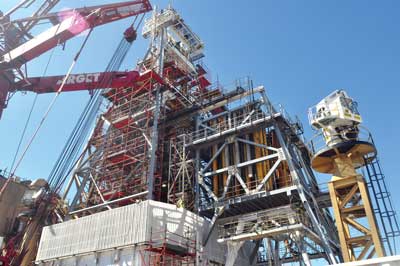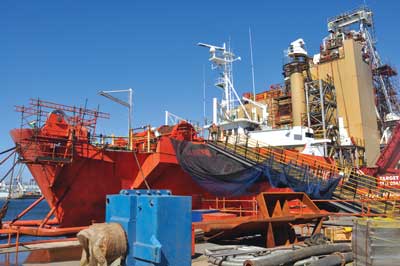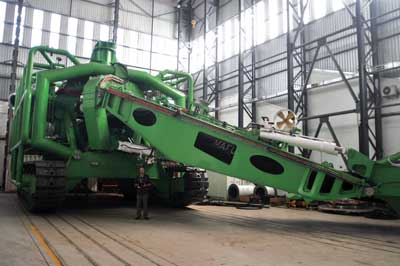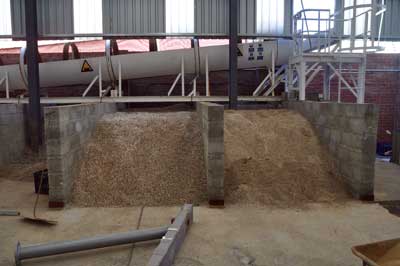 |
| Domingos Valbom, general manager at De Beers Marine, in the Debmar Pacific control room. |
WHILE THE SHIP IS REPAIRED AND OUTFITTED FOR ANOTHER 30-MONTH STINT AT SEA, E&MJ DISCUSSES SEABED DIAMOND MINING WITH THE BEST IN THE BUSINESS.
By Gavin du Venage, South African Editor
Miners have all manner of difficulties to manage in the field, but not many have to contend with barnacles. De Beers is one of the very few companies to operate seagoing diamond recovery, and E&MJ was given an exclusive look at one of its vessels in a rare call to port.
The Debmar Pacific made an unscheduled call to Cape Town harbor toward the end of December following a minor fire aboard the vessel. Usually she spends up to three years at sea, churning the waters off Namibia, 1,000 km to the north, where she hunts for alluvial diamonds from the ocean floor.
She is part of a six-vessel fleet managed by Debmarine Namibia (Namdeb), a 50:50 joint venture between the Namibian government and De Beers. The operation is a world leader in sea floor diamond mining that recovers up to 1 million carats (ct) every year, accounting for more than half of Namdeb’s total diamond production.
“Marine diamonds are the very best quality there is,” said Domingos Valbom, general manager at De Beers Marine, which manages De Beers’ half of the Namdeb venture. “They’ve been washed down rivers to the sea over millions of years. Lesser quality stones get broken up along the way—only the hardest, best quality stones survive to be deposited on the seabed.”
Diamonds in the mining areas are found in laterally extensive, but thin, gravel deposits. These average no more than 300 mm in thickness throughout most of the mining license. The diamonds within these gravel deposits were eroded from kimberlites found in the southern African hinterland cratonic areas. As these erode, the stones are freed and transported by water to the coastal areas through the palaeo-Orange River drainage system. They are eventually deposited on the seabed and dispersed, over time, across a wide area.
After the removal of shell material from the plant feed by means of various comminution technologies, the gravel is fed through DMS cyclone pumps to produce a heavy, diamond-enriched residue that is airlifted via helicopter to the shore, for further processing.
 |
| Drilling tower on the Debmar Pacific. |
Seagoing Mining Camp
The Debmar Pacific is one of four drilling vessels that together with a “crawl ship” or dredger, and an exploration vessel, complete the flotilla.
The vessel is supplied daily by helicopter that takes care of crew circulation as well as the delivery of food and spare parts. A launch is used to handle larger consignments that are too big for a helicopter to carry. Every three months or so, a tanker pulls up alongside to refuel the Debmar Pacific. She is the ultimate seagoing mining camp.
Her day-to-day operational needs, such as resupply and routine maintenance, are met in Namibia from Luderitz, the Debmar Pacific’s home port. For major overhauls and drydocking, she is sent farther south to Cape Town.
Debmar Pacific uses an airlift drill of 6.8 m in diameter that bites into the ocean floor somewhere between 90 to 120 m below the surface. The drill itself is stabilized by compensating cylinders at the surface that match the rise and fall of the ship as she bobs on the waves.
“The vessel moves, but as long as it is at work, the drill remains stationary,” said Valbom. “The whole ship carries out the same processes found in a land-based diamond mine—she is a mine at sea.”
The process recovers sediment on the sea floor, which is then sucked up to the vessel above. The gravel is dewatered and sized, with waste being eliminated by vibrating primary screens in a tower-like structure in the center of the ship. Chutes protruding from the side dispense muck over the side.
 |
| Debmar Pacific docked in Cape Town. |
Maintaining Production
Not surprisingly, the vessel takes a pounding during her prolonged stay at sea. “We handle most repairs on the ship,” said Phillip Koa, the Debmar Pacific’s master. “The crew is on average 60 people—20 to operate the ship and the rest are artisans and technical people.”
The crew works a 12-hour on/12-hour off shift, and is rotated out every 28 days. The Debmar Pacific follows a precise drill plan drawn up and based on the result of earlier research conducted by the exploration vessel, which drills holes in a wide pattern in a potential mining area. The sampling is used to plot a grid of tightly placed holes that pack together like a large block of Swiss cheese. Each is precisely plotted according to GPS coordinates so that when the Debmar Pacific drops her drill, it touches down on the seabed on an exact pre-planned drill location. Over a year, she will mine around 5 km2 of seabed.
Four anchors—two each located port and starboard of the bow and stern—keep the ship in place while drilling is under way.
“Each hole is drilled for about six or seven minutes before the drill comes back up,” Koa said. “We work 24 hours a day in all weather, but when swells start hitting 5 m, that’s when we think about shutting down.”
The pace is intensive, and it has to be. Pinned to the notice board on the bridge of the vessel is a simple number: N$155,000 ($14,000). “This is what it costs the company each hour the ship is not working. Everyone on board is aware of this number at all times.”
To put that in perspective, the daily rate to hire an entire Capespan ore carrier begins at around $20,000 a day. An idle Debmar Pacific clocks in at nearly $300,000 per day in lost production—an eye-watering sum for Namdeb’s bean counters to digest.
This call to port was unscheduled but that does not mean it will be entirely wasted. A crew of technical experts was pulled together to carry out all the maintenance tasks that would have been done in her later scheduled stop. When she departed port in late February, the Debmar Pacific was ready for another 30-month cruise.
“I got the call a day after Christmas,” said Eddie Bruwer, shutdown coordinator, whose job it is to manage the maintenance project. “It took us a week to get everyone together and we are doing everything that needs to be done in the shortest time possible.”
Anything up to 800 men at a time were toiling on the ship as she rested at a Cape Town dock. That’s an awful lot of people crowded onto a space designed to house no more than 60.
 |
| De Beers’ latest crawler at their research facility in Cape Town. |
Advancing Crawler Technology
The revamp of the ship goes further than routine repairs; it also allows for newer technology to replace existing systems. “Our exploration process means we identify possible sites to mine, but because of technical challenges it may not be possible to do so profitably,” said Valbom. “As our technology develops we can then consider mining areas that we have previously passed by. Calls to port are part of our upgrading process and allow us to keep advancing our onboard technology.”
Technology is advancing in other spheres as well. Not far from where the Debmar Pacific was laid up, at a research facility about two miles away, is De Beers’ latest project—a 300-ton monster of a crawler.
This is the third generation of a technology that the company hopes will eventually be the future of undersea mining. The crawler will be based on the newly renamed Mafuta, which in Namibia’s Oshiwambo language means “oceans.” In an earlier life, the ship could claim to have been the world’s largest cable laying vessel, until De Beers bought it for around $60 million and converted it to a seabed dredger.
The Mafuta has spent the past few years lowering earlier generations of crawlers onto the seabed and controlling them remotely from the surface. The crawler is connected to the ship by a 650-mm internal diameter rubber hose through which the seabed material is pumped to the plant, using a 2.4-megawatt IHC centrifugal dredge pump.
“The problems with this technology are engineering problems, and these we thought could be solved,” said Michael Winstanly, project manager for the crawler’s development. “The latest version has a bigger weather window in which it can operate and is more tolerant of fluctuations on the seabed.”
The crawler is designed to stay underwater for up to a year, when it is raised to the surface for maintenance and repairs. “It takes quite a pounding down there so a year is our limit,” said Winstanly.
Control is managed via a console that transmits the signal to the operator using a camera to guide the crawler’s movements on the surface. “It’s like a super games console,” Winstanly said.
On the seabed it moves on tracks like a submarine tank, while at the business end at the front a nozzle on a pivot sweeps in an arc from side-to-side, sucking up sediment. This is drawn to the surface and processed in a similar manner to that employed on the Debmar Pacific.
Should the crawler need to be brought to the surface, it will be lifted by its single tether into the bottom of the vessel’s hull through a sliding hatch in a process fans of the Thunderbirds will appreciate.
Currently the drill ships still dominate the De Beers fleet. The latest crawler cost around $10 million to design and build and is still an evolving technology. “With each design we adjust for problems encountered with the previous version. It’s taken years of blood, sweat and tears to get this far,” added Winstanly.
 |
| Different grades of seabed sand used in the research project to develop mining crawlers. |
Minimizing Environmental Footprint
Seabed mining is in its infancy but has already drawn the ire of environmentalists. De Beers has commissioned several studies into the effects of its activities. Unlike surface mining, rehabilitation of a mined site is currently not possible. However, the company is confident that environmental consequences are minimal.
Drilling takes place at around 100 m below the surface, out of reach from life-essential light and under crushing pressure where very little survives. Even the hardiest of crustaceans—the ocean’s bottom feeders—do not venture much below 60 m. Coral reefs and their inhabitants, which are found much closer to the surface are, therefore, not affected.
However, as one study commissioned by the company candidly admits, “the communities that live in the targeted soft sediment areas are typically destroyed during the mining processes.” These are mostly microorganisms that live in the bottom substrates, and their destruction, while regrettable, only causes temporary damage; the mined areas are quickly repopulated by unaffected colonies of organisms living nearby.
It’s not clear yet whether this technology is easily translatable to other minerals. De Beers has a joint venture to search for gold with AngloGold Ashanti off the west coast of Southern Africa, as well as a couple of other experimental plays. The results so far have been inconclusive.
Still, De Beers is confident overall in its technology, although it has opted not to patent it. This is a strategic move, because to document each technical change its developers make would keep an army of lawyers busy. It will also create a useful paper trail for competitors. In any case, De Beers reckons that it is one thing to gain access to the technology; quite another to operate it profitably in an environment that is a ceaseless ballet of moving water, shifting ocean seabed and heaving vessels.
“It’s all about how profitable this tech is—and I don’t think anyone is close to where we are,” Valbom concluded.









